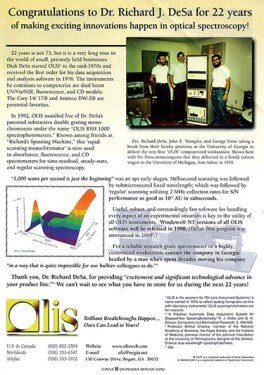The smart Trick of Spectrophotometers That Nobody is Discussing
The smart Trick of Spectrophotometers That Nobody is Discussing
Blog Article
Our Uv/vis Ideas
Table of ContentsThe Single Strategy To Use For Circularly Polarized LuminescenceAll about Uv/visUv/vis/nir Can Be Fun For Anyone7 Easy Facts About Spectrophotometers ShownThe 2-Minute Rule for Spectrophotometers

Although spectrophotometry is most typically used to ultraviolet, noticeable, and infrared radiation, modern-day spectrophotometers can question broad swaths of the electromagnetic spectrum, including x-ray, ultraviolet, noticeable, infrared, and/or microwave wavelengths. Spectrophotometry is a tool that depends upon the quantitative analysis of molecules depending on just how much light is taken in by colored compounds.
Little Known Facts About Spectrophotometers.
A spectrophotometer is typically utilized for the measurement of transmittance or reflectance of options, transparent or nontransparent solids, such as polished glass, or gases. Although many biochemicals are colored, as in, they take in visible light and therefore can be determined by colorimetric procedures, even colorless biochemicals can typically be converted to colored compounds suitable for chromogenic color-forming reactions to yield substances appropriate for colorimetric analysis.: 65 Nevertheless, they can also be created to measure the diffusivity on any of the noted light varieties that normally cover around 2002500 nm using various controls and calibrations.
An example of an experiment in which spectrophotometry is utilized is the decision of the equilibrium constant of a solution. A particular chain reaction within an option may take place in a forward and reverse instructions, where reactants form products and products break down into reactants. At some point, this chain reaction will reach a point of balance called a stability point.
Indicators on Spectrophotometers You Need To Know
The quantity of light that goes through the solution is a sign of the concentration of certain chemicals that do not permit light to go through. The absorption of light is due to the interaction of light with the electronic and vibrational modes of particles. Each type of molecule has an individual set of energy levels related to the makeup of its chemical bonds and nuclei and hence will take in light of particular wavelengths, or energies, resulting in special spectral properties.
They are widely used in numerous industries including semiconductors, laser and optical production, printing and forensic evaluation, as well as in labs for the research study of chemical substances. Spectrophotometry is frequently index utilized in measurements of enzyme activities, determinations of protein concentrations, decisions of enzymatic kinetic constants, and measurements of ligand binding reactions.: 65 Eventually, a spectrophotometer is able to determine, depending on the control or calibration, what compounds are present in a target and exactly how much through calculations of observed wavelengths.
This would come as a service to the previously developed spectrophotometers which were not able to soak up the ultraviolet properly.
The Definitive Guide for Uv/vis
It would be discovered that this did not give satisfying results, therefore in Design B, there was a shift from a glass to a quartz prism which enabled much better absorbance results - UV/Vis/NIR (https://www.artstation.com/julieanndesalorenz1/profile). From there, Design C was born with a modification to the wavelength resolution which ended up having 3 systems of it produced
It was produced from 1941 to 1976 where the cost for it in 1941 was US$723 (far-UV accessories were an alternative at extra cost). In the words of Nobel chemistry laureate Bruce Merrifield, it was "most likely the most essential instrument ever developed towards the advancement of bioscience." Once it ended up being terminated in 1976, Hewlett-Packard created the very first commercially offered diode-array spectrophotometer in 1979 called the HP 8450A. It irradiates the sample with polychromatic light which the sample takes in depending on its properties. Then it is sent back by grating the photodiode range which spots the wavelength area of the spectrum. Given that then, the development and implementation of spectrophotometry devices has actually increased exceptionally and has become one of the most ingenious instruments of our time.

All About Spectrophotometers
Historically, spectrophotometers utilize a monochromator consisting of a diffraction grating to produce the analytical spectrum. The grating can either be movable or fixed. If a single detector, such as a photomultiplier tube or photodiode is utilized, the grating can be scanned stepwise (scanning spectrophotometer) so that the detector can determine the light intensity at each wavelength (which will represent each "step").
In such systems, the grating is repaired and the strength of each wavelength of light is determined by a various detector in the selection. When making transmission measurements, the spectrophotometer quantitatively compares the portion of light that passes through a reference solution and a test solution, then electronically compares the strengths of the 2 signals and calculates the portion of transmission of the sample compared to the recommendation standard.

Report this page